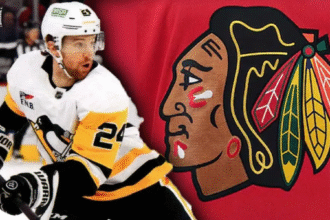The offseason has arrived for three-quarters of the NHL, with teams that missed the playoffs or were eliminated in the first round shifting their focus. It’s time to assess what these teams need to achieve in the upcoming months. Let’s take a closer look at Montreal.
As the Canadiens continue their rebuilding phase, expectations remained modest at the start of the season. They ended up in the same position as the previous year – 28th – with slight improvements in goals, goals conceded, and points.
Having missed the postseason for three consecutive years after their Cup Final appearance, there’s a growing expectation for improvement as the team aims to transition out of its rebuild phase. Consequently, GM Kent Hughes is likely to be exploring moves to bolster both the team’s future prospects and its performance in the next season.

Clear Defensive Logjam
The Montreal Canadiens boast one of the league’s deeper defensive rosters in terms of team depth. Just a year ago, they regularly fielded four or even five rookies in a single game, but they didn’t feel pressured to make changes until their next wave of prospects was ready to challenge for ice time.
Now, that upcoming talent is nearing readiness. Jayden Struble, initially slated for the minors this season, ended up playing 56 games at the NHL level. Lane Hutson and Logan Mailloux both had brief stints in the NHL towards the end of the season and performed adequately. David Reinbacher, the fifth overall pick from last year, will be a regular fixture in North America next season and is expected to get some NHL action.
With a total of eight defensemen playing at least 44 games for Montreal this season, all of whom are either under contract or subject to restricted free agency, there’s already a congestion on the blue line. Even before factoring in the prospects pushing for roster spots, there’s a slight bottleneck. However, if management believes Hutson or Mailloux are ready for full-time duty or close to it, they might consider moving two of their current defensemen.
Some anticipate that David Savard, set to become an unrestricted free agent in 2025, might be traded, although the team could hold onto him until closer to the trade deadline to maintain his mentorship role with the young players. Jordan Harris could be seen as a potential candidate for departure. At 23, he’s versatile, affordable with a $1.4M contract for one more year, and capable of logging significant ice time.
Additionally, Justin Barron, now eligible for waivers and unable to be sent back to the minors after spending most of the latter half of the season there, might also be considered for a move. As a pending restricted free agent, the 22-year-old former first-round pick, with nearly 100 NHL games under his belt, could fetch considerable value if the Canadiens decide to trade him.
Extension Discussions
Last offseason, the primary focus revolved around negotiating Cole Caufield’s contract as he approached restricted free agency for the first time. This time, there isn’t anyone of comparable impact requiring a new deal, allowing Hughes to concentrate on securing early extensions for a couple of key young players.
At the start of the season, Juraj Slafkovsky struggled significantly, prompting suggestions that he should be demoted to the minors. Instead, Montreal opted to promote him to the top line, which proved to be a turning point for him. Subsequently, he flourished, amassing 35 points in the final 40 games of the season. This transformation has shifted him from being a likely candidate for a short-term contract to someone Montreal will likely aim to sign on a long-term basis.
Given Montreal’s salary structure, it’s plausible to assume they’d prefer to slot him in behind Nick Suzuki, whose contract is worth $7.875 million per season. However, considering the typical compensation for first-overall picks on long-term deals, Slafkovsky might seek more. If negotiations lean towards the latter, it wouldn’t be surprising for both parties to delay discussions until the 2025 offseason to determine if his performance surge was an anomaly or a consistent trend.
Another significant candidate eligible for an extension is Kaiden Guhle. The 22-year-old defenseman transitioned from junior two years ago and has been logging over 20 minutes per game in his first two seasons. Despite having a somewhat limited offensive contribution, he could still command upwards of $6 million per season on a maximum-term contract.
However, Guhle has grappled with injuries in both seasons, making an extension a somewhat risky proposition for both parties. Guhle risks potentially leaving money on the table if he manages to stay healthy and perform exceptionally well next season, while Montreal faces the gamble of committing significantly to a player prone to injuries. Nevertheless, if Guhle remains healthy, Montreal could potentially secure him at a favorable rate. Thus, finding a mutually agreeable number should be a priority for both sides.
Add Scoring Help
Montreal hasn’t reached the upper echelons of goal-scoring in the league since the 2018-19 season. They’ve consistently ranked low in goals scored over the past few years, with only Suzuki and Caufield managing to surpass the 20-goal mark this season. While the top line, featuring Suzuki, Caufield, and Slafkovsky, shows promise, the team still lacks sufficient scoring depth.
The return of Kirby Dach, who missed most of the season due to a knee injury, and the anticipated development of Alex Newhook offer hope for internal improvement. However, relying solely on internal growth won’t be adequate to push them back into playoff contention.
The Canadiens have a track record of shying away from free agency, preferring instead to bolster their roster through trades. With an extra first-round draft pick at their disposal, they’re expected to continue this trend, possibly targeting players like Dach and Newhook. Additionally, there’s speculation that they might explore the free-agent market for short-term solutions to enhance scoring depth and provide mentorship to their young players. However, they’ll need to make a decision before July 1st regarding this approach.
Escape Or Utilize LTIR
Two years ago, Montreal opted for offseason LTIR, granting them flexibility to acquire Sean Monahan from Calgary in exchange for a 2025 first-round pick. This decision paid off as they signed Monahan to a cost-effective one-year deal, later trading him for another first-rounder earlier this season.
Last summer, they chose not to repeat this strategy, instead waiting until the in-season to place Carey Price on LTIR, offering them more flexibility. However, they didn’t capitalize on this flexibility.
Given this, it may not be the wisest choice to follow the same approach this time. Price still has two years remaining on his $10.5 million contract, albeit unable to play anymore. Selling him will be challenging due to $11 million in unpaid signing bonuses.
Therefore, Hughes must decide whether to revert to offseason LTIR or not. By doing so, they could actively participate in free agency or absorb a short-term costly contract akin to the Monahan deal. Despite the cap increasing by over $1 million, there will likely be teams seeking to shed salary. Although this move would yield more future benefits, such as draft picks, it might not concern them if they don’t foresee playoff contention.
Alternatively, if they opt against offseason LTIR, they could consider exiting LTIR altogether. With approximately $78.6 million in commitments, they have room to accommodate potential seven-figure contracts for their restricted free agents Barron and Arber Xhekaj. This would leave them with space to add a player while remaining under the cap ceiling, allowing them to save funds for in-season flexibility or to evade a bonus overage for the third consecutive year, which would benefit their cap situation in the following season. They should finalize their strategy before the commencement of free agency.





